YORK
Merchant Adventurers Hall
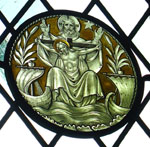 In
1357 a groupof prominent men and women of York met to form a confraternity
dedicated to the Holy Trinity. Confraternities functioned as commercial
unions, fraternal organizations that provided support in times of crisis,
and social units. A modern stained glass roundel reproduces the configuration
(but not the style) of the original shield of the confraternity. The name
was later changed to the Company of Merchant Adventurers. Since this organization
provided the central meeting area of the merchant class in York, its seems
probable that Margery Kempe, daughter of a Lynn mayor, would have had
some dealing with individuals associated with the Guild of the Trinity.
Margery herself was admitted as a member of the Trinity Guild in Lynn
in 1440. In
1357 a groupof prominent men and women of York met to form a confraternity
dedicated to the Holy Trinity. Confraternities functioned as commercial
unions, fraternal organizations that provided support in times of crisis,
and social units. A modern stained glass roundel reproduces the configuration
(but not the style) of the original shield of the confraternity. The name
was later changed to the Company of Merchant Adventurers. Since this organization
provided the central meeting area of the merchant class in York, its seems
probable that Margery Kempe, daughter of a Lynn mayor, would have had
some dealing with individuals associated with the Guild of the Trinity.
Margery herself was admitted as a member of the Trinity Guild in Lynn
in 1440.
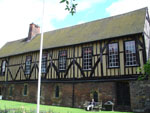 The The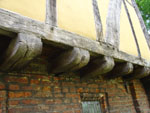 exterior of the Hall, built in the late 14th century shows it's impressive
size, commensurate with the position of York as one of the premier cities
of the realm, a city that had already supported the construction of its
cathedral's Chapter house
impressive enough for a meeting of Parliament. The construction technique
of exposed beams is typical of the secular building of its time, and similar
houses are still extant in the city, many on or near the street called
the Shambles.
exterior of the Hall, built in the late 14th century shows it's impressive
size, commensurate with the position of York as one of the premier cities
of the realm, a city that had already supported the construction of its
cathedral's Chapter house
impressive enough for a meeting of Parliament. The construction technique
of exposed beams is typical of the secular building of its time, and similar
houses are still extant in the city, many on or near the street called
the Shambles.
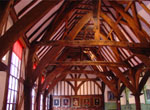 Given
the large size of the Hall, both the upper and lower floors are divided
down the center. Since the beams of English oak used for the Given
the large size of the Hall, both the upper and lower floors are divided
down the center. Since the beams of English oak used for the  roof
would not span the entire width of the hall, its roof is actually two
pitched roofs side by side. Oak, when well cured and kept dry has remarkable
strength. Like many parish churches of the times, the wooded upper structure
is one of the most striking visual features of the building. On the left,
the hall shows later portraits of prominent citizens of York and royalty.
The area to the right shows an 18th-century altar decoration that once
must have contained texts of the Commandments, Lord's Prayer, or other
Scripture. roof
would not span the entire width of the hall, its roof is actually two
pitched roofs side by side. Oak, when well cured and kept dry has remarkable
strength. Like many parish churches of the times, the wooded upper structure
is one of the most striking visual features of the building. On the left,
the hall shows later portraits of prominent citizens of York and royalty.
The area to the right shows an 18th-century altar decoration that once
must have contained texts of the Commandments, Lord's Prayer, or other
Scripture.
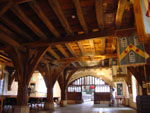 From
1373 the undercroft, the lowest level, was used as a From
1373 the undercroft, the lowest level, was used as a 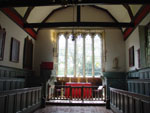 hospital
for the indigent. Both the physical and spiritual needs were met thought
caretakers and a designated chaplain. The hospital was dedicated to Our
Lord Jesus Christ and the Blessed Virgin Mary and its chapel, constructed
in 1411, had three altars, stained glass, statues, and other furnishing
typical of a parish church, all of which were removed in 1549 as part
of the decrees against "superstitious images." hospital
for the indigent. Both the physical and spiritual needs were met thought
caretakers and a designated chaplain. The hospital was dedicated to Our
Lord Jesus Christ and the Blessed Virgin Mary and its chapel, constructed
in 1411, had three altars, stained glass, statues, and other furnishing
typical of a parish church, all of which were removed in 1549 as part
of the decrees against "superstitious images."
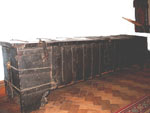 An
oak evidence chest dates from the late 13th century. It was purchased
by the Merchant Adventurer's Guild in the early 15th century and appears
in an inventory list of 1488. Thus it is easily the kind of object that
Margery Kempe would have seen in her many interviews with individuals
of importance. An
oak evidence chest dates from the late 13th century. It was purchased
by the Merchant Adventurer's Guild in the early 15th century and appears
in an inventory list of 1488. Thus it is easily the kind of object that
Margery Kempe would have seen in her many interviews with individuals
of importance.
|

